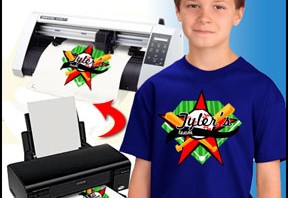 Direct to garment printing has come a long way since it first hit our industry as a decorating method that is here to stay back in 2004. There have been many highs and lows and today you have a wide range of choices all of which fit certain business models. The down side is the relatively high investment cost of the equipment at first which means you must have a market in place to quick realize any return on investment. So how do you get into that market and not run your self out of business first? Heat Transfers is the answer!
Direct to garment printing has come a long way since it first hit our industry as a decorating method that is here to stay back in 2004. There have been many highs and lows and today you have a wide range of choices all of which fit certain business models. The down side is the relatively high investment cost of the equipment at first which means you must have a market in place to quick realize any return on investment. So how do you get into that market and not run your self out of business first? Heat Transfers is the answer!
In my nearly 10 years of working in the direct to garment industry (I was the VP of Sales and Marketing for the now defunct U.S. Screen which sold the T-Jet line of direct to garment machines) I found the worst enemy of the machines and leading cause of printing issues was letting the machine set idle. The more the machine ran the less issues people had and the quicker they saw the return on investment. With the development of better inks, better more robust print heads and innovative ink “agitation” systems, direct to garment makes it easier for all its users but still, these are inkjet machines which have small ink openings and they can and will dry up due to lack of uses.
Now while the direct to garment industry grew and innovated, so did the t-shirt transfer side of the business. No longer do you need to associate the paper heat transfer with the crummy stuff you got from your local office supply store the was applied with a hand iron and wash maybe once or twice if you were lucky. Today’s commercial grade transfer paper that is applied with a heat press, is soft to the touch and hold up to many washings while at the same time giving you the flexibility to apply single customized images to both light and dark garments of all varieties. And with the addition of a cutting plotter that has an optical eye you can easily remove the boarder everyone so feared without spending hours with a pair of scissors.
So how do these seemingly rival decorating methods fit together? Well as I explained you must have a market in place to realistically expect to be successful with direct to garment printing. But how do you do that while not currently owning a direct to garment machine? You do transfers and build your market until you realistically have enough work to keep your direct to garment machine running daily.
You can begin doing individual customized garment with transfer paper for less than $2,200 (which will get you a 16 x 20 heat press, a 13” x 19” Epson inkjet printer, a 15” cutting plotter with optical eye and 100 sheets of light and dark transfer paper.) This system uses standard inkjet inks that are specifically designed for the print heads (unlike direct to garment inks which have larger pigments and tend to settle and clog more). Then you can grow your market, lets your printer sit while you are gaining new business and save up the money for that direct to garment printer you have been eying.
Let’s say for the sake of this article in both the t-shirt transfer and direct to garment print you have $3.00 in the cost of the shirt, paper and ink (direct to garment can vary depending on the amount of ink used, light or dark garment, so I’m just assuming black shirt, average coverage). Let’s say you sell that individually customized shirt for $15 (I hope you are getting more, don’t sell yourself short, you could easily charge $20 or more for a single shirt). That is $12.00 in profit per shirt. You would have to sell 184 shirts to pay for the transfer paper set-up while you would have to sell between 1,250 to 2,000 shirts to pay for the average direct to garment machine.
Transfers with today’s technology can get you in the short run garment decorating business and be your bridge to having a successful direct to garment business, versus one filled with headaches and difficult equipment leasing payments. I’m happy to help anyone look at their business model and show you how to be successful. Email me at aaron@coastalbusiness.com.
Aaron Montgomery
Sales and Marketing Manager
Coastal Business Supplies, Inc.
www.coastalbusiness.com
aaron@coastalbusiness.com

Great point. I was considering both of these options, but as you stated it is hard to afford a garment printer right away. I may email you, after all I am doing this on my own without help from a single person! But hey, the internet is a reference guide, right?
Thanks,
Amanda B
Lexington, KY
Amanda – Give me a shout any time. I really believe the transfer path is the best way to success. Now with the new OKI Data White Toner printers available you can have a wonderful system for less than $4,000 and build your business before investing $20,000 in a DTG.